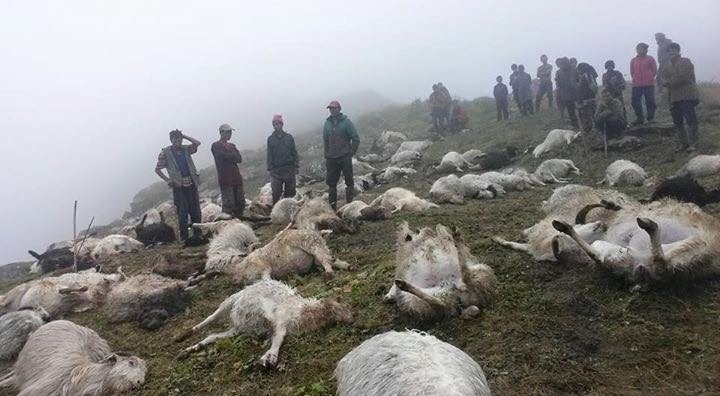Science & Technology

Lightning strikes are one of the deadliest disasters yet they make few headlines.
On average, about 2,500 people are killed every year in south Asia by thunderbolts. Several recent incidents of lightning strikes killing grazing cattle en masse have come to light.
Consider these.
- Over 50 goats plus a cow and an ox were killed in a lightning strike while they were grazing in a remote pasture in Humla, reports said on Friday.
- In August 2020, another massive thunderbolt killed at least 500 sheep that were grazing in highland pastures.
- In July 2019, at least 35 cows – resting in a shed - were killed when lightning struck at them in Prayagraj in north India.
There are several incidents of such en masse killings of livestock across South-Asia, including Himalayan highlands, Indo-Gangetic, Brahmaputra basins.
How lightning kills cattle?
The phenomenon of lightning is simply a discharge event of the charged clouds. Lightning events are categorised into two broad groups: cloud to cloud and cloud-ground.
Cloud-ground lightnings are the killers.
When a lightning strikes, it searches for the easiest path to the ground and whatever is easy to travel through, it travels through, often killing the living beings.
Electrically speaking, experts say, animals and humans are more conductive than air, because of the electrolyte (salt) rich water-filled body. Whenever possible, lightning finds its way through animals and humans to the ground.
Anything higher than the plain ground is caught because it is easier for lightning to travel through.
“There are five types of lightning strikes: direct strike, side flash, ground current, conduction and streamers,” as mentioned by the US government’s National Oceanic and Atmospheric Administration (NOAA).
Also, the ‘ground current’ can be blamed for the mass killings of the cattle.
When a thunderbolt strikes on a spot, NOAA says, “the electric jolt travels outward from the strike in and along the ground surface within a certain radius, which is called ground current”.

It is the lightning’s biggest danger, as it affects a large area, anyone inside the radius is the victim of the electric shock, it adds.
This current can travel into the body through one leg and get out of the other - possibly stopping the vital organs.
A physical phenomenon called ‘step-potential’ is involved which is the voltage between the feet of a person/animal standing near an energized grounded object (here the spot of lightning strike).
The wider the step—the spread of legs—higher the potential and higher the potential, higher is the severity of electric shock. Cattle being quadrupedal—having four feet, they are at a huge disadvantage in contrast to bipedal humans.
Their forelimbs and hind limbs are quite spread out than the humans, so the chances of them getting killed is higher than the bipedal.
So, when the ground gets electrified, almost all the cattle standing on that particular stretch of ground can get killed, as it happened in a lot of recent events across South Asia.






